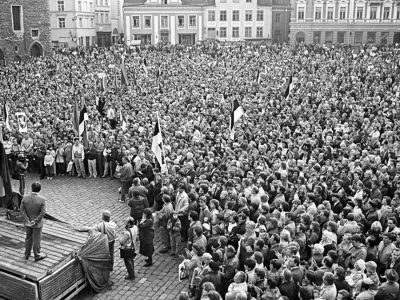Education for the Proletariat: To produce more you need to know more. Some of the most innovative, radical, and successful literacy campaigns are those that are born out of revolutions. At the time of the revolution, the vast majority of Russians were peasants toiling under big landowners and eking out a meager existence. More than 60 … More Time to Educate![]()
Category: 4th Weekly Edition
The Kronstadt Rebellion
by •
Kronstadt was a small island turned naval fortress, which had originally been allies of the Bolsheviks after the February Revolution of 1917. On the island, the sailors considered themselves to be loyal to the Soviet cause. Eventually though, anger arose as a result of the authoritarian regime the Bolsheviks were building. They began to deprive […]![]()
The New Economic Policy: Not Very Socialist, but Effective
by •
Due to Vladimir Lenin’s strong association with socialism/communism, early Soviet economic policy can be a bit jarring, especially the New Economic Policy of 1922. The NEP, in fact, was strangely capitalist. The NEP allowed for something of a free market, though it was still tightly controlled by the government. It allowed for investment in industry … Continue reading “The New Economic Policy: Not Very Socialist, but Effective”
Church of Gold
by •
“What can the church of gold give us? Russia could be fed this year and the next!” Source: Hoover Political Poster Database. 2007. With all of the cultural changes happening during the early 1900’s, I found the changing of religion … Continue reading →
The Famine of 1921-22
by •
Throughout the time of the Russian Revolution, we have seen many different instances of food shortages; in some form or another. With the famine of 1921-22, the food shortages started to become, in nature, very political. During this time, the government would take food from the peasants and give it to those in the Red … Continue reading The Famine of 1921-22![]()
Trading Space for Time
by •
Treaty of Brest Litovsk. March 3, 1918 Following the October Revolution, the Bolsheviks sought to make good on their promise of peace, land, and bread for all. The new Communist Regime opened up peace negotiations with Germany, Austria-hungry, and the Ottoman Empire. The Treaty of Brest Litovsk, named after a small Ukrainian town, was the ensuing peace document that developed out of … Continue reading Trading Space for Time![]()
Bolsheviks on top
by •
picture source: http://diehardgamefan.com/2012/08/23/tabletop-review-reds-the-russian-civil-war-1918-1921/ The Russian Civil War began in the winter of 1917/18. By the spring of 1918, the Bolsheviks had extended their authority to the Russian heartland but could hardly claim to have a firm grasp of power. Within the civil war, there were the “Reds” and the “Whites,” the “Reds” being the Bolsheviks and … Continue reading Bolsheviks on top![]()
Snatching God’s Thunderbolts
by •
In February 1920, the All-Russian Central Executive Committee of the Soviets established The State Electrification Commission (GOELRO), kicking off the first major economic overhaul under the Bolsheviks. The GOELRO sought construct thirty new power stations, reaching a total capacity of 1,000,000 kW within 10 to 15 years (up from 1,038 kW). Expanding access to electrical power was significant […]![]()
The 10th Party Congress
by •
Lenin, Trotsky and Voroshilov with Delegates of the 10th Congress of the Russian Communist Party in 1921. “During the closing months of the civil war, the population increasingly demanded that the state produce tangible improvements to justify the sacrifices made in the name of revolution…Even the most ideological Bolshevik could not deny the gravity of […]![]()
The “Living” Church: When Wine Turned to Blood
by •
Ok, so joke’s on you. The church isn’t really alive, nor is this post about some old world Russian sorcery, (which would be really cool!) This “Living” Church is not focused on a building, but on a movement. Known as the Renovationist Movement, The Living Church Movement started as part of a schism of… Continue reading The “Living” Church: When Wine Turned to Blood →![]()
